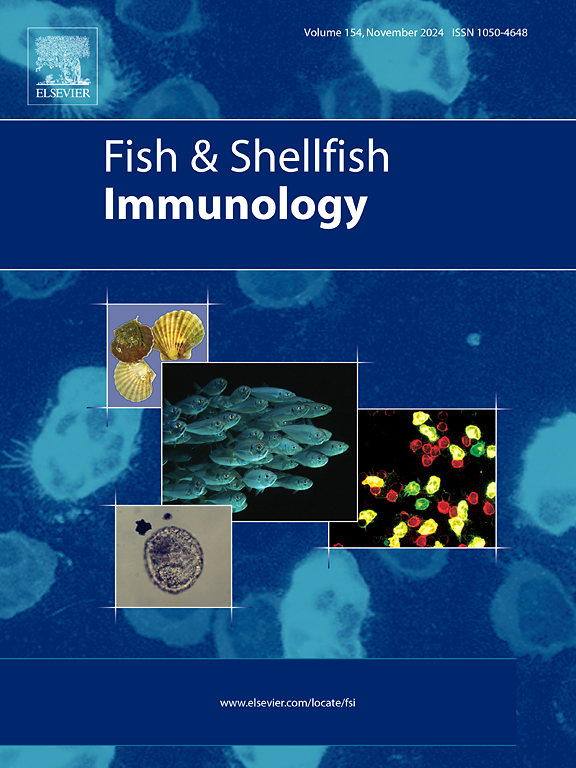大西洋鲑吞噬细胞对碳源变化和暴露于 PAMPs 的代谢能量适应。
IF 3.9
2区 农林科学
Q1 FISHERIES
引用次数: 0
摘要
吞噬细胞是宿主体内平衡和感染防御的关键,需要在糖酵解、三羧酸(TCA)循环和氧化磷酸化(OXPHOS)方面进行代谢调整。哺乳动物的吞噬细胞在极化过程中会转向糖酵解和谷氨酰胺酵解,但有关鱼类吞噬细胞代谢重编程的研究却很有限。为了解决这个问题,大西洋鲑鱼吞噬细胞系 SHK-1 成为了一个有价值的模型。本研究利用海马 XFe96 通量分析仪,比较了 SHK-1 在葡萄糖限制(L-15 培养基)和葡萄糖补充(PM)条件下的生物能,从而深入了解其代谢特征以及对大马哈鱼鱼立克次体细菌病原体相关分子模式(PAMPs)的反应。图中显示了在 PM 和 L-15 培养基中研究 SHK-1 新陈代谢实时变化、确定耗氧率(OCR)和细胞外酸化率(ECAR)的标准化方案。在 PM 培养基中生长的 SHK-1 细胞具有较高的基础和最大 OCR 和备用能力(SRC),而在 L-15 培养基中生长的 SHK-1 细胞则偏向于 OXPHOS,糖酵解功能极低。尽管存在代谢差异,但细胞内 ATP 水平相当,这凸显了 SHK-1 细胞的代谢可塑性和对各种碳源的适应性。暴露于来自沙门氏璧立克次体的 PAMPs 会诱导代谢转变,增加糖酵解和 OXPHOS,影响 ATP、乳酸盐、谷氨酰胺和谷氨酸水平。这些发现强调了线粒体生物能和代谢可塑性在鲑鱼吞噬细胞中的作用,为基于能量代谢的宿主-病原体干预提供了新的营养策略。本文章由计算机程序翻译,如有差异,请以英文原文为准。
Metabolic energetic adaptation of Atlantic salmon phagocytes to changes in carbon sources and exposure to PAMPs
Phagocytic cells are pivotal for host homeostasis and infection defense, necessitating metabolic adaptations in glycolysis, the tricarboxylic acid (TCA) cycle, and oxidative phosphorylation (OXPHOS). While mammalian phagocytes shift towards glycolysis and glutaminolysis during polarization, research on fish phagocyte metabolic reprogramming is limited. To address this, the Atlantic salmon phagocytic cell line, SHK-1, serves as a valuable model. Using the Seahorse XFe96 Flux Analyzer, this study compares SHK-1 bioenergetics under glucose-restricted (L-15 medium) and glucose-supplemented (PM) conditions, providing insights into metabolic characteristics and responses to Piscirickettsia salmonis bacterium Pathogen-associated molecular patterns (PAMPs). A standardized protocol for the study of real-time changes in the metabolism study of SHK-1 in PM and L-15 media, determining oxygen consumption rate (OCR) and extracellular acidification rate (ECAR) is shown. Exhibiting metabolic adaptations, SHK-1 cells in the PM medium have higher basal and maximal OCR and spare capacity (SRC), while those grown in the L-15 medium favor OXPHOS, showing minimal glycolytic function. Despite metabolic differences, intracellular ATP levels are comparable, highlighting the metabolic plasticity and adaptability of SHK-1 cells to various carbon sources. Exposure to PAMPs from Piscirickettsia salmonis induces a metabolic shift, increasing glycolysis and OXPHOS, influencing ATP, lactate, glutamine, and glutamate levels. These findings highlight the role of mitochondrial bioenergetics and metabolic plasticity in salmon phagocytes, offering novel nutritional strategies for host-pathogen interventions based on energy metabolism.
求助全文
通过发布文献求助,成功后即可免费获取论文全文。
去求助
来源期刊

Fish & shellfish immunology
农林科学-海洋与淡水生物学
CiteScore
7.50
自引率
19.10%
发文量
750
审稿时长
68 days
期刊介绍:
Fish and Shellfish Immunology rapidly publishes high-quality, peer-refereed contributions in the expanding fields of fish and shellfish immunology. It presents studies on the basic mechanisms of both the specific and non-specific defense systems, the cells, tissues, and humoral factors involved, their dependence on environmental and intrinsic factors, response to pathogens, response to vaccination, and applied studies on the development of specific vaccines for use in the aquaculture industry.
 求助内容:
求助内容: 应助结果提醒方式:
应助结果提醒方式:


